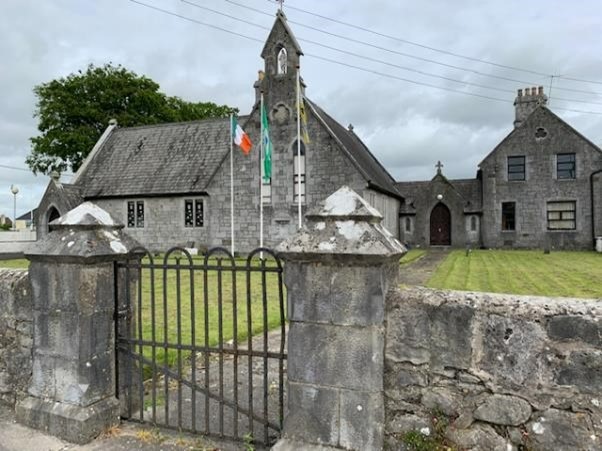History of Croom
Croom is located north of a junction in the river system, where the Camoge River joins the Maigue. Croom was a place of considerable importance from an early date, but it did not develop as a town until the castle was built. The town was walled in 1310, and over the intervening years both town and castle had times of prosperity and decline.
Croom’s history date’s back to pre-Christian or early Christian times. In 1972-1973 two single-banked ring forts were demolished in the townland of Croom, to build new houses on the site. Elizabeth Shee-Twohig excavated these sites in March 1974. She discovered human and animal remains, an iron knife, a bronze penannular ring and a bone comb side-plate. A preservation order was placed on a third ring fort nearby. These forts were located north of the Croom-Rathkeale road, one mile from Croom, and over 65 ring forts are shown on a survey sheet No. 30 of the 6-inch Ordnance survey maps, two to three miles South-West of these excavated sites.
Tory Hill just outside Croom, towards Crecora is said to have been home to the kings of Munster, in 1852 a gold Lunula (2000-500BC) was discovered here and is housed in the National Museum of Ireland. Dysert Aengusa, Croom has the remains of a church and round tower from with the initial buildings dating from 780
The history of Croom as a town begins with the coming of the Normans, when a powerful branch of the Geraldine’s, or Fitzgerald’s, settle in Croom. There were two great branches of the Geraldine’s, the Munster or Desmond Geraldine’s, and the Kildare Geraldine’s. It was the latter who, for a time, had their headquarters in Croom. They owned extensive tracts of land in the Maigue valley, including lands at Croom and Adare, while their Kinsmen, the Munster Geraldine’s, owned the greater part of the rest of Co. Limerick.

Later, the Geraldine’s of Croom were to move from their Maigueside base and make Maynooth in Co. Kildare their main residence. But they never forgot their early association with Croom, regarding it as their ancestral headquarters. Indeed, their motto and war-cry continued to Be ‘Crom Abu’ (victory to Croom). Although Maynooth was now their principal seat, the Kildare Geraldine’s still retained their Maigueside lands and castles, and members of the family resided in Croom, from time to time.
The countess of Kildare happened to be in Croom in the winter of 1601 when Red Hugh O’ Donnell, arrived in Croom with his men after their incredible night march across the frozen Slieve Felim marshes. They were on their way to link up with the Spaniards who had landed at Kinsale to aid the Irish then in revolt against the English. O’ Donnell was received at Croom castle by the Countess. Some of the original buildings of Croom Castle remain and are occupied.

Croom was an important crossing on the river Maigue, giving access into Connello, the huge West Limerick barony, which figured prominently in the Elizabethan wars. In the civil survey, of 1654, after the Cromwellian war, the description of Croom was: "there is a broken bridge on the river of Maigue near the castle”. Croom has endured difficult periods
Some Gaelic poets who lived in Croom in the following century warmly sang its praises. Indeed, Croom owes much of its later fame to the school of Gaelic poetry (Scoil Eigse, Cuirt Eigse) that flourished here in the 18th century. The poets of the Maigue school, which was probably a convivial gathering in a pub owned by one of the poets, were know as Fili na Maighe, the poets of Maigue. Chief among them was Sean O’ Tuama, owner of the hostelry in question; next in importance was Aindrias Mac Craith, a hedge school master, who had settled in Croom, and who was better known as, An Mangaire Sugach (The merry pedlar). The Maigue poets wrote songs and poems including a lovely song, ‘’ Slan le Maigh” (farewell to the Maigue), by Aindrias Mac Craith. MacCraith and O’Tuama both hailed from Killmallock and although friends they apparently sparred laterally through the medium of limericks. O’Tuama died in 1775 and is interred in the cemetery of the Church of Ireland in Croom.
A workhouse was built in Croom in the 1840’s to house the destitute of the famine, the nearest workhouse being in Newcastle West. The building was adapted in 1924 as a general hospital serving all of county Limerick, and as such enjoyed a great reputation all over the county. With the building of the Limerick Regional Hospital in 1956, Croom Hospital became a Regional Orthopaedic Hospital. The hospital continues to be a centre for excellence in orthopaedic medicine




